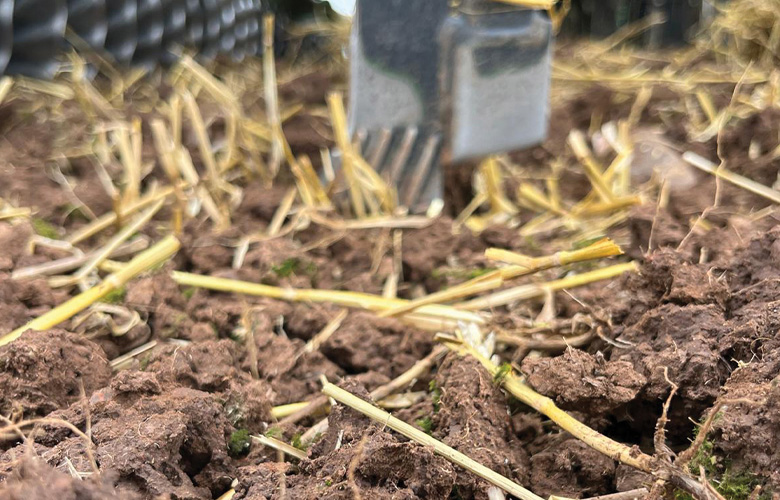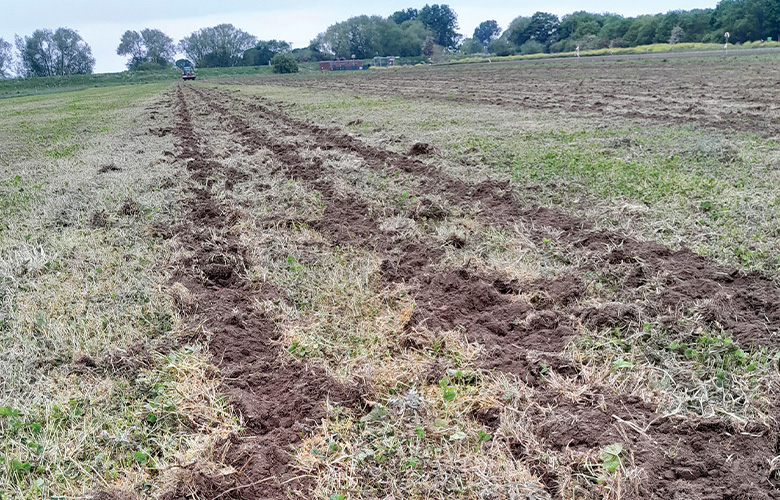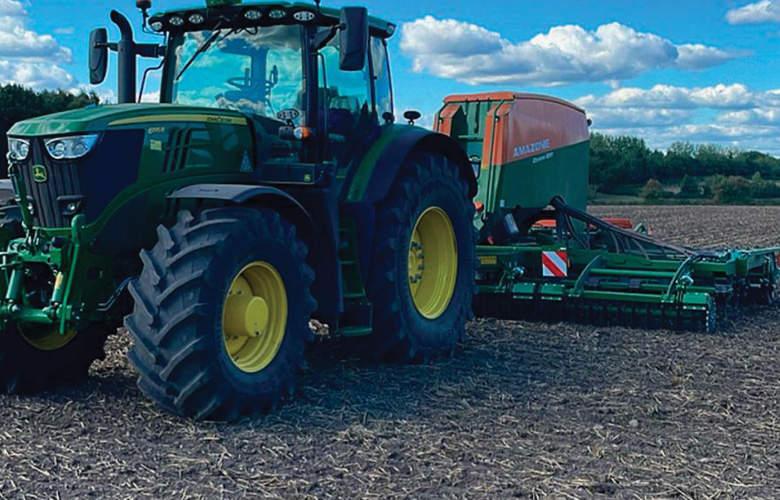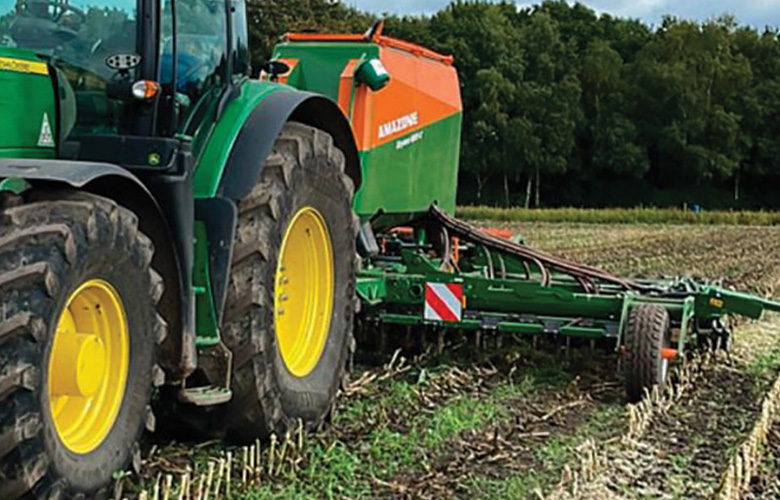- Soil Association
- Farmers & growers
- Low-input farming advice
- Min-till and no-till
- Technical guide for reducing cultivations

Technical guide - reducing cultivations
Download a printable PDF of this reducing cultivations technical guide.
How to reduce cultivations
What do we mean by reduced cultivation?
Reduced cultivation is also known as minimum or conservation tillage. It involves using shallower and less intensive soil disturbance, compared to conventional ploughing, to create seedbeds in both arable and horticultural systems.
Conventional cultivations are used to create the ideal conditions for seeds to germinate and plants to grow. But, they can also harm soil structure, disrupt natural biological processes, increase erosion risk, and release stored carbon.
Reduced cultivation typically avoids full soil inversion. It instead disturbs only the top 10–30mm of soil, using tools like disc cultivators to create an acceptable seedbed. These may be paired with deeper tines to loosen soil beneath the surface. Techniques vary from cultivating the full machine width to strip tillage, where only narrow bands are worked. Some systems go further, planting directly into undisturbed soil (no-till).
Benefits include better soil structure, reduced erosion, improved water retention, and lower fuel costs. However, it may also lead to increased reliance on herbicides. It is also not equally suited to all soil types where cultivations are needed to prevent compaction or keep soil structure open. Nonetheless, most soils can support reduced cultivation methods in at least some seasons or under certain conditions.
Getting started with reduced cultivations
Field selection is an important first step. Select fields that are not compacted and that you intend to plant with crops not requiring deep seedbeds. Additionally, selecting fields with low crop residue levels and low weeds levels, particularly perennial weeds, will give best initial results. Where there are weeds, making sure they are left on the surface to dry out prior to drilling is essential to prevent regrowth.
A key distinction in seedbed preparation is that with conventional ploughing, you are looking for an ‘ideal’ seedbed which may be better than you need for the crop. With reduced cultivations, you aim to achieve an ‘acceptable’ one. Getting this balance right can be challenging at first. As the soil health improves, achieving a sufficient friable seedbed for successful establishment does become easier.
In the short term there may be some reduction in yield due to soil biology and mineralisation changes. But, as it adapts, increases in soil carbon and better aggregation of particles should lead to a return to average yields.

Strip till planting into wheat stubble, Field Hall Farm, Staffs

Strip tillage in broccoli with clover, Pollybell Farm, S Yorks
Scientific evidence about the impact of reduced cultivation
Reduced cultivation, ranging from minimum tillage to strip-till or no-till, has been widely adopted to enhance soil structure, reduce input costs, and support long-term soil resilience.
By minimizing soil disturbance, reduced cultivation maintains deeper soil pores and structures. This improves water infiltration, root development and microbial activity. It can reduce erosion and runoff (Palm et al., 2014; Holland, 2004), enhancing nutrient cycling and benefiting long-term soil health and resilience.
Soil organic matter is better preserved at the surface. Limited oxidation of organic matter contributes to higher soil organic carbon levels over time compared to conventional ploughing. However, with reduced physical mixing to depth, this carbon accumulation may be limited to the top layers, with little increase in total organic carbon at ‘plough depth’ of ~30cm and deeper (Six et al., 2002). This carbon at depth change will be dependent on the rooting depth of the crop used (Button et al., 2022).
The outcome of reduced cultivation varies by soil type, climate and management system. The ideal cultivation method is often influenced by soil type (see Soil type arable crops, AHDB). Clay soils may need occasional deeper loosening (like sub-soiling) to maintain root access and prevent compaction.
As with all resilient farming systems, the combination of approaches taking a ‘whole farm system approach’ is key. The integration of organic matter additions (e.g. manures, composts) and cover cropping improve the outcomes for soil biology and fertility in reduced cultivation systems (see Reducing cultivations, Soil Association).
Crop yields under reduced tillage are often comparable to conventional tillage, though transitional periods can cause variability (Pittelkow et al., 2015).
Innovative Farmers Farm Net Zero maize trials showed strip-till methods have reduced costs by lowering fuel use, while maintaining yields within 5% of ploughed fields.
Weed pressure remains a key limitation for reduced cultivations. Increased herbicide dependency or mechanical weeding costs can reduce the possible net economic gains (Economic and Ecological benefits of reduced tillage 2017). Therefore, in organic farming systems, where herbicide weed control is not an option, the use of targeted reductions in cultivations rather than a whole system change is advised.
Whole farm system thinking
Reduced cultivations can lower labour time needed and fit within other operation timelines better. This makes it easier to implement during busy periods on the farm. With this lower time pressure, it is possible to wait on ideal conditions rather than trying to force seedbeds, working with the weather more.
Reduced cultivation does not need to be an all or nothing approach. Soil structure and health can still be maintained or increased with the occasional targeted use of deeper cultivations. This includes subsoiling or even full inversion ploughing when needed, for weed and trash management or for root crops.
With less cultivations at depth, cover crops and deep rooting crops may be needed to maintain soil structure, water infiltration and prevent compaction. They, along with organic manures and composts, are essential if increases in soil organic matter are an objective of moving to reduced cultivations.
Measuring and monitoring
Improved infiltration will lead to drier, more friable soils that are easier to cultivate. However, if over time, infiltration rates get slower, it means there is sub-surface compaction and possible reduction in soil health needing additional remediation. Rotational ploughing, perhaps for specific crops within the rotation, is a common strategy when soils get tighter through reduced movement.
Monitoring increase in weeds and crop health is important. Rather than resolutely sticking to a one system approach, be willing to adapt with some flexibility. Target specific actions to help deal with any issues that may arise.
Although soil carbon or soil organic matter tests are a good indicator of soil health improvements, it is important to sample to the same depth. This should ideally be at least 30cm. Reducing cultivation depth does mean that soil organic matter (or soil carbon) may become stratified in the top surface. Therefore, total organic matter in the 0-30cm depth may not change despite organic matter in the top 15cm increasing.
Impact
Possible short-term reductions in yields will quickly recover to average levels. Longer-term improved soil structure and better soil biology will lead to increasing yields, lower fertiliser use, easier worked soil and further reductions in fuel and time use creating seed beds.
These improvements over time will increase profitability, with a reduction of inputs supporting better business resilience and economic viability.
Better soil health will also benefit the wider environment, resulting in less erosion and run-off risk, enhancing biodiversity and ecosystem resilience.
The key challenge to these benefits is the successful management of weed control where ploughing is not part of the system. Costs may increase with need for mechanical weeding. In non-organic systems, herbicide costs can increase, as can the risk of herbicide resistance if there is no rotational cultural weed control. Of course, poor weed management can lead to crop failure or reduced crop quality.

Drilling into shallow cultivated stubble, Field Hall Farm, Staffs

Drilling into maize stubble, Field Hall Farm, Staffs
Machinery requirement
Aside from equipment, there are no additional costs to reducing cultivations, except the possible need for more herbicide in non-organic systems or need for mechanical weeding.
Machinery requirements for reduced cultivations tend to only need smaller tractors than those used for ploughing. However, larger tractors maybe more economic to run when not working at depth.
There are a range of reduced cultivation machines so selecting one for your soil type is important. Seeking advice and trialling them is the best way to find out what will work for you. The aim is to select a machine that cultivates an appropriate seedbed for germination. This will protect against predation of seeds and germinating plants. Additionally, achieving this with a limited number of passes is important for soil structure. Too many passes to create a suitable seedbed can compact soil, becoming as damaging as ploughing.
A joined-up approach to both cultivations and drilling is also essential. Suffolk coulter type drills need a firm fine seed bed to ensure consistent drilling depth, whereas disc and tine drills are less ‘fussy’. Time and disc drills do not require such fine seedbeds, meaning that less intense cultivations are needed to create a seedbed. They provide more flexibility when plough-based cultivations are still part of the farming system. But they can still be used when shallow or reduced cultivations are being used to ensure seed placement is consistent. Therefore, the drill system needs consideration when moving to reduced cultivations as it too may need changing.
Strip drills, where cultivations are limited only to the drill strip are commonly being used to combine cultivations and drilling. These will generally involve rigid tines which can drill directly when soil conditions allow, but can also be used on ploughed and cultivated soils. Where deeper rooting crops are used such as maize and brassicas, strip till cultivators can be used. These cultivate a narrow strip to depth and is followed by a precision drill which plants into that cultivated strip.
Technical Guide - Reducing Cultivations
DownloadCASE STUDY:
We moved from a plough-based system to disc cultivation. As soil structure and health improved, we used a Mzuri tine drill which plants in cultivated strips leaving most of the soil unmoved. An important part of this evolution has been the use of cover crops that are grazed. This has ensured soil structure, porosity and organic matter are maintained. We have seen improvements in soil health, an increase in earthworm numbers, and have reduced fertiliser and agrochemical inputs without loss of crop yield.Tregooden Farm, Cornwall
